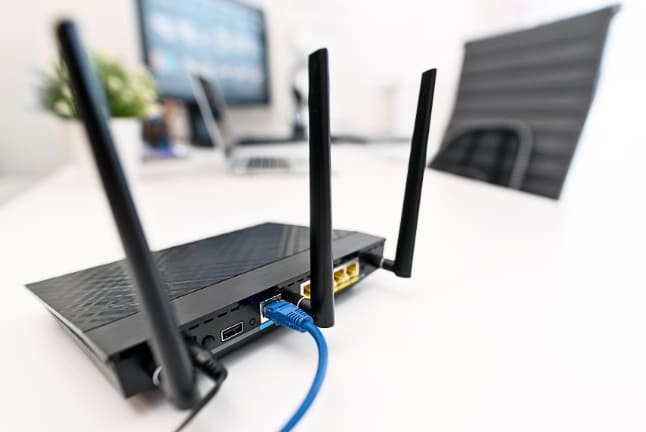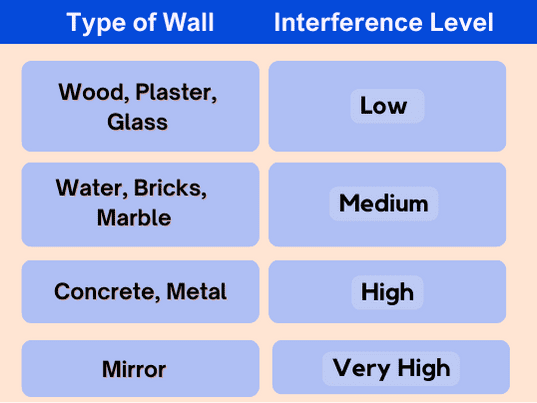Best Place to Put Router for Strong Signal in Apartment
With so many devices relying on Wi-Fi, from smartphones to smart home gadgets, the placement of your router can make or break your online experience.
It’s a strategic decision that impacts from video streaming quality to how much speed your smart devices can download and upload. Let me share some insights on the keys to placing the router in the best position and having consistent Wi-Fi coverage.
Choosing a Best Place to Put Router
To find the best spot for the router in an Apartment, you need to know the basics of how radio waves travel. Radio waves propagate evenly in all directions from the radiation source.
It became clear that the central location of the house is prime for ensuring an even distribution of Wi-Fi signals. It must be an open place and more than 1 m high from the floor. Placing the router in the hallway, for instance, often means the signal can propagate more evenly across the living area, minimizing the chances of dead spots.

However, there can be instances where a central location isn’t feasible due to layout or aesthetic concerns. In such cases, moving the router closer to where the Wi-Fi is most used—like near the living room or office space—can be a strategic move.
Because the reduction is also exponential: if at 1 meter the signal is optimal, at 2 meters it is a quarter as strong as it is at one meter, and 3 meters it is a ninth as strong as it is at one meter.
For larger or more challenging spaces, the use of a repeater can be a game-changer. This device amplifies the signal from the primary router, extending the reach of the 2Ghz and 5Ghz Wi-Fi network. It’s beneficial if the optimal router placement isn’t enough to cover the entire Apartment.
Common Router Placement Mistakes
Some common placement mistakes can significantly impede your network’s efficiency. Let’s get into some of these errors so you can avoid them.
Don’t Put Your Router in a Corner
One of the most frequent mistakes is placing a router in a corner of the apartment. It might seem logical, especially if you’re trying to keep the device out of sight. However, this placement limits the signal’s reach.
WiFi signals spread outwards in all directions, so when a router is tucked away in a corner, a significant chunk of its signal ends up going outside or being absorbed by the walls. So that’s why you want your router positioned centrally to ensure even distribution of WiFi throughout your apartment.
Close to Metal Objects
Another placement mistake is positioning your router too close to metal objects. Metal is highly effective at blocking WiFi signals, which can cause interference and weaken your network’s coverage.
Items like metal shelves, filing cabinets, or even large appliances can create a sort of signal “shadow,” leading to dead zones in your WiFi coverage. I’ve had to learn this the hard way, so I recommend keeping your router away from large metal objects to avoid unnecessary signal disruption.

Avoid the Kitchen
The kitchen is often the heart of the home, but it’s one of the worst places for your router. Kitchens typically contain a lot of interfering metal appliances.
Refrigerators and microwave ovens, in particular, operate on a frequency very close to that of WiFi, leading to potential signal disruption whenever you’re heating your meals. It’s best to find a spot for your router that’s far away from the kitchen and its electronic complexities to maintain a stable connection.
Other Common Router Placement Mistakes
Beyond the primary mistakes mentioned above, here are a few additional router placement errors to avoid:
- Behind Thick Walls: Thick walls, especially those made of brick or concrete, can significantly prevent your WiFi signal from transmitting. Always aim for a location with as few physical obstructions as possible.
- Near Windows: While it might seem inconsequential, placing your router near a window can result in a portion of your signal being sent outside, reducing its effectiveness indoors.
By avoiding these common router placement mistakes, you’re setting yourself up for a more reliable WiFi network in your apartment. The key is to be mindful of your router’s environment and to position it in a location that maximizes its potential to deliver a strong, uninterrupted signal to your devices.
Tips for Improving Your Wi-Fi and Eliminating Dead Zones
Finding the best place to put your router in an apartment is about more than just the initial setup. It’s also about tweaking to ensure the strongest signal throughout your space. Here are some strategies I’ve found effective in eliminating those annoying Wi-Fi dead zones and boosting overall signal quality.
Adjust the Antennas on Your Router
The first step I usually take is to adjust the antennas on my router. It might seem like a minor tweak, but it can significantly impact your Wi-Fi coverage. Most routers come equipped with omnidirectional antennas, meaning they send signals in all directions.
If your router has two or more antennas, try setting them perpendicularly – one vertically and the other horizontally. This orientation ensures that the signal covers both horizontal and vertical planes, which is ideal since the orientation of Wi-Fi receiving devices varies.
Fact: Each antenna emits signals in an elliptical shape, most vital in the direction perpendicular to the antenna. So, arranging antennas at different angles maximizes the chance that one of the signals aligns with your device’s receiver for a more robust connection.
Switch the Frequency
There’s one more thing your home Wi-Fi network struggles with: your neighbors’ Wi-Fi networks . Most Wi-Fi networks still use the 2.4 GHz frequency.
If you are connected to the same channel as your neighbor, the signals may overlap and make it difficult to enjoy a stable connection. The 5 GHz networks of modern routers that support the 802.11ac WiFi standard have more 5GHz channels and offer more options in this regard, but not all devices are compatible.
Add More Wireless Points to Your Network
In apartments with multiple rooms or levels, one router might not cut it, no matter where you place it. In such cases, adding more wireless points is an excellent option to improve your Wi-Fi coverage and eliminate dead zones.
Mesh networks are fantastic for this purpose. They consist of the main router that connects directly to your modem and a series of satellite modules, or nodes, placed around your home for fuller Wi-Fi coverage.
What I appreciate most about mesh networks is their seamless connectivity. Devices automatically switch to the strongest signal as you move throughout the space, ensuring an uninterrupted connection. It’s like having multiple routers throughout your apartment but without the hassle of manually connecting to the nearest one.
By adjusting your router’s antennas and adding more wireless points to your network, you’re well on your way to enjoying a more reliable and rugged Wi-Fi signal in every corner of your apartment.
FAQs
How high off the floor should a WiFi router be?
US internet provider Ritter Communications explains to place your router five to seven feet off the ground with a clean line of sight. This height optimizes the WiFi signal distribution throughout your space.
Can a WiFi signal go through walls?
Yes, WiFi signals can go through walls; however, their ability to do so effectively can depend on the material of the walls. While drywall, plywood, and glass usually pose little issue for wireless signals, thicker walls made of reinforced concrete may block or weaken the signal.
Is it ok to have a mirror near the router?
Do not place the router in front of mirrors or other reflective surfaces; behind them, the signal can get deficient.
Can a fish tank affect a wireless signal?
If you have a fish tank and the signal does not reach you well, perhaps you should place the router (or the fish tank) somewhere else because wireless signals have a tough time transferring those water tanks.
[Related]
- What is WPS Button on a Router? Its Purpose and Uses?
- How to Find Out Password (Default) on a WiFi Router?
- Lights on the Router are on, but the Internet not Working?
- Why Wi-Fi not working but Ethernet is? Here’s how to fix it.
